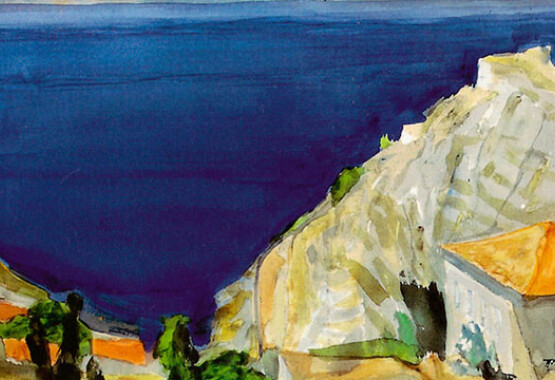
KALAMATA
The items are arranged and displayed in a manner that will win your attention and whet your appetite to learn more about the area’s history and culture.
In Trifylia Province section, there are local finds from settlements ruled by king Nestor of Pylos, known from Homer’s Iliad as one of the kings who followed Agamemnon, king of Argos, to his expedition and war against Troy. You will see exhibits unearthed from Mycenaean shaft graves such as a single vessel from a tomb dating to the Middle Helladic Period (part of Bronze Age, c. 2000-1550 BC) at Pyrgos Trifylias location, and a golden cup from Peristeria location, one of the precious offerings found in royal tombs. See also the coins of ancient Kyparissia town whose harbour was of great importance during the Hellenistic and Roman times.
In Messene Province section, displayed objects from Ancient Messene are few, as excavated items from the area are to be found at the Archaeological Museum of Ancient Messene. Among the exhibits you will see the Armoneikos herm with inscriptions on it, a large number of local coins found during the excavation of the ancient town, as well as sections of the remarkable mosaic floor of a Roman villa at Desylla area.
In Pylia Province section, there are finds from ancient Koroni town (present-day Petalidi), from the sanctuary of Apollo of Kory(n)thos at Agios Andreas Longas location, and from the Mycenaean shaft graves at Platanovrysi, Chandrinos, Koukounara, Kremmydia and Soulinari locations. Among the exhibits you can see an impressive late Roman mosaic floor. The Nichoria section is particularly interesting, and comprises three units: the first is about the precious offerings from the Royal Mycenaean shaft grave; in the second, you will see objects of daily use from the settlement; and the third includes antiquities from a row of graves, dating to the Mycenaean [c. 1600-1100 BC], Geometric [c. 1050-700 BC] and Classical Period (c. 500-320 BC).
In Kalamata Province section, there are impressive copper votive offerings unearthed from the Sanctuary of goddess Artemis Limnatis at Volymnos, Artemisia; another interesting group of exhibits is called Akovitika, where excavations brought to light the sanctuary of Poseidon (Archaic & Classical Period 700-480 BC & 480-320 BC) and the remains of two Early-Helladic palaces (c. 3300-2100 B.C.). On display there is also a hippocampus (seahorse) figurine, a mythical being related to the worship of god Poseidon.
Archaeological Museum of Messenia
In the heart of the old marketplace in Kalamata town, surrounded by cobblestone streets, traditional cafés and ouzeris (a type of taverna that serves ouzo), the Archaeological Museum of Messenia welcomes you for a trip to the area’s long past; its exhibits date back to the ancient times, from prehistory (Bronze Age) all the way to the Byzantine Period.The items are arranged and displayed in a manner that will win your attention and whet your appetite to learn more about the area’s history and culture.
The Museum Tour
The arrangement of exhibits takes place in four big location-based chapters after the four old provinces of the region; Kalamata, Messene, Pylia and Trifylia. They include findings from the most important archaeological sites, as per province. Start with viewing the map of Messenia region, where you will see the locations the exhibits came from. The items are arranged in a direction that resembles the flow of local Pamisos River branching off into its tributaries, leading the visitors into the four sections /provinces of the exhibition. Each one is a self-contained unit which allows you to visit just the part you’re interested in -if you so wish- without needing to see other sections.In Trifylia Province section, there are local finds from settlements ruled by king Nestor of Pylos, known from Homer’s Iliad as one of the kings who followed Agamemnon, king of Argos, to his expedition and war against Troy. You will see exhibits unearthed from Mycenaean shaft graves such as a single vessel from a tomb dating to the Middle Helladic Period (part of Bronze Age, c. 2000-1550 BC) at Pyrgos Trifylias location, and a golden cup from Peristeria location, one of the precious offerings found in royal tombs. See also the coins of ancient Kyparissia town whose harbour was of great importance during the Hellenistic and Roman times.
In Messene Province section, displayed objects from Ancient Messene are few, as excavated items from the area are to be found at the Archaeological Museum of Ancient Messene. Among the exhibits you will see the Armoneikos herm with inscriptions on it, a large number of local coins found during the excavation of the ancient town, as well as sections of the remarkable mosaic floor of a Roman villa at Desylla area.
In Pylia Province section, there are finds from ancient Koroni town (present-day Petalidi), from the sanctuary of Apollo of Kory(n)thos at Agios Andreas Longas location, and from the Mycenaean shaft graves at Platanovrysi, Chandrinos, Koukounara, Kremmydia and Soulinari locations. Among the exhibits you can see an impressive late Roman mosaic floor. The Nichoria section is particularly interesting, and comprises three units: the first is about the precious offerings from the Royal Mycenaean shaft grave; in the second, you will see objects of daily use from the settlement; and the third includes antiquities from a row of graves, dating to the Mycenaean [c. 1600-1100 BC], Geometric [c. 1050-700 BC] and Classical Period (c. 500-320 BC).
In Kalamata Province section, there are impressive copper votive offerings unearthed from the Sanctuary of goddess Artemis Limnatis at Volymnos, Artemisia; another interesting group of exhibits is called Akovitika, where excavations brought to light the sanctuary of Poseidon (Archaic & Classical Period 700-480 BC & 480-320 BC) and the remains of two Early-Helladic palaces (c. 3300-2100 B.C.). On display there is also a hippocampus (seahorse) figurine, a mythical being related to the worship of god Poseidon.




